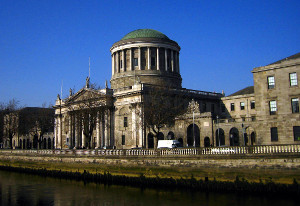Court of Appeal: Personal injuries award reduced from €155,000 to €83,000 for accident arising from dazzled driver

The Court of Appeal has allowed an appeal to reduce a general damages award from €155,000 to €95,000 on the basis that the trial judge did not properly assess general damages under the Book of Quantum. Further, the court held that the plaintiff was liable in contributory negligence for his accident and therefore had his total award reduced to €83,000.
Delivering a majority judgment in the case, Mr Justice Seamus Noonan held that the trial judge’s findings of fact indicated that the plaintiff was partly responsible for the accident. The court also applied recent case law and said that €155,000 was not a proportionate award compared to other similar injuries.
Background
The plaintiff had been driving his car on a road in the Ring of Kerry in November 2014. He was 21 years old at the time and training to be an electrician. It was a dark morning and the road was damp.
The road was relatively narrow and the plaintiff was driving at approximately 75 km/h. As he rounded a right-hand curve in the road, the plaintiff claimed to be met by a “wall of light” coming in the opposite direction from the defendant’s lorry. The plaintiff claimed to have been dazzled by the full beam lights and crashed into the lorry on the defendant’s side of the road.
The plaintiff suffered significant injuries to his knee and shoulder and brought personal injuries proceedings against the defendant. At trial, the defendant contested the plaintiff’s version of the events.
In particular, the defendant argued that the plaintiff failed to brake when he claimed to be dazzled, despite the plaintiff claiming that he did brake. The expert evidence stated that the accident occurred at about 100 km/h, which was consistent with the plaintiff failing to brake before the accident.
Further, it was argued that the plaintiff failed to stay in his own lane and swerved onto the defendant’s side of the road. The defendant relied on photographic evidence of the crash to show that the plaintiff’s vehicle was fully in the defendant’s lane at the time of impact. The plaintiff had maintained in evidence that he stayed in lane. The evidence also established that the lorry was a few inches inside the plaintiff’s side of the road.
The defendant also argued that the plaintiff should have seen the lights of the lorry from a distance and reacted appropriately by slowing down. As such, it was argued that the defendant had enough time to stop his vehicle and avoid the accident entirely.
The trial judge held that the defendant was fully liable for the accident and assessed general damages at €155,000, with €85,000 for pain and suffering to date and €70,000 into the future. In reaching this conclusion, it was held that the defendant’s lights were on at the time and that they caused the plaintiff to be dazzled. It was accepted that the accident occurred on the defendant’s side of the road and that the plaintiff was travelling at 75 km/h.
Finally, the court also relied on the evidence of the plaintiff’s expert engineer, who gave evidence about the how the dazzling lights would impair the decision-making capacity of the plaintiff. The defendant appealed the decision to the Court of Appeal on both causation and quantum.
Court of Appeal
Delivering a majority judgment in the case, Mr Justice Noonan held that the trial judge had erred in his assessment of the evidence and, in particular, failed to engage with certain aspects of the evidence. The court noted that the trial judge had implicitly rejected the plaintiff’s evidence that he had stayed in his lane or that he had applied the brakes prior to the accident.
Further, the court noted that the accident could have been entirely avoided if he had stopped when he first saw the light. The court held that the expert evidence established that the plaintiff could have stopped in time. The court held that “it was simply not credible” that the plaintiff failed to slow down due to being dazzled by the lights.
It was held that the trial judge failed to engage meaningfully with this evidence. Had the plaintiff acted by slowing down or staying in lane, he would have simply passed by the lorry, the court said. It was therefore held that the plaintiff was partially liable for the accident.
Further, Mr Justice Noonan held that the trial judge erred in law by relying on the expert evidence regarding a person’s reaction to being dazzled. The court held that the expert was an engineer who had no basis to provide this opinion of behavioural psychology.
The court held that the trial judge was correct to find that the primary cause of the accident was the defendant driving with full beam headlines into oncoming traffic, the court held that the plaintiff was negligent. As such, the court applied a one-third contributory negligence finding against the plaintiff.
On the issue of quantum, Mr Justice Noonan held that the trial judge had erred by awarding €155,000 for general damages. There was no dispute about the injuries suffered by the plaintiff. It was noted that the plaintiff had multiple surgeries, had ongoing pain in his knee from the accident and could not work as an electrician.
Mr Justice Noonan considered cases such as Leidig v. O’Neill [2020] IECA 296 and McKeown v. Crosby [2020] IECA 242, in which he had held damages must be proportionate to the general cap on damages. The court also outlined that it must be satisfied that no reasonable proportion existed between the original award and general damages cap before it could interfere with an award (Nolan v Wirenski [2016] 1 IR 461 considered).
The court held that it was acceptable to compare awards between cases in order to reach a conclusion on the proportionality of an award, although a court had to be aware that no two cases were exactly alike (see McKeown v. Crosby). The court compared the present case to Leidig, which had some similar features regarding the injuries to the plaintiff. The court noted that an original award of €115,000 for general damages was reduced to €65,000 on appeal.
The court had reference to the Book of Quantum and held that the trial judge’s award was so disproportionate that it amounted to an error of law. The court held that the plaintiff’s injury fit into the severe category of patella fractures at the upper end. The shoulder injury was described as being at the lower end of the scale.
The court therefore decided that general damages should be assessed as €60,000 for pain and suffering and €35,000 for future pain and suffering. The court also held that the trial judge failed to separately assess the plaintiff’s loss of opportunity due to no longer being able to work as an electrician. The court assessed loss of opportunity at €25,000 and special damages at €5,968.
Conclusion
The court applied the one-third contributory negligence finding to the total award, which left the plaintiff with €83,000.
Notably, Mr Justice Seamus Woulfe delivered a judgment in which he held that the plaintiff should only be held 20 percent liable for the accident. Mr Justice Woulfe also held that his personal assessment of the case totalled €140,000, which was not so disproportionate to overturn the trial judge. Accordingly, Mr Justice Woulfe would have awarded the plaintiff €128,000.






